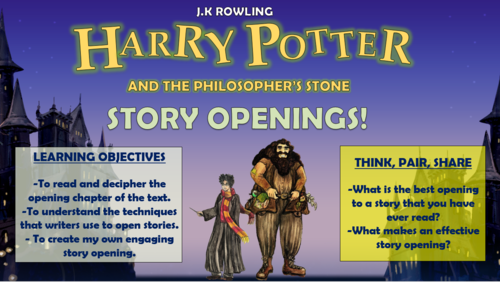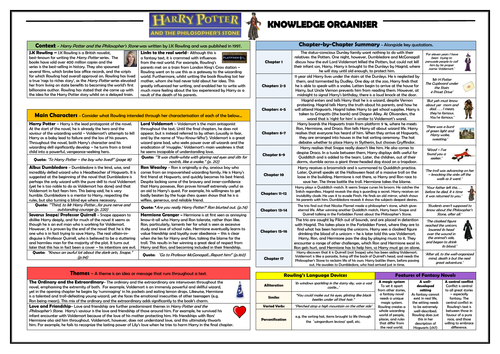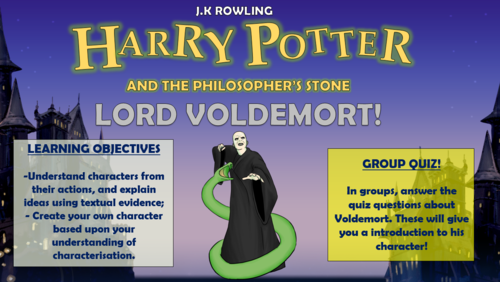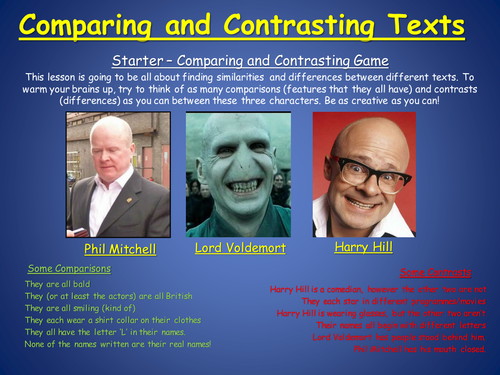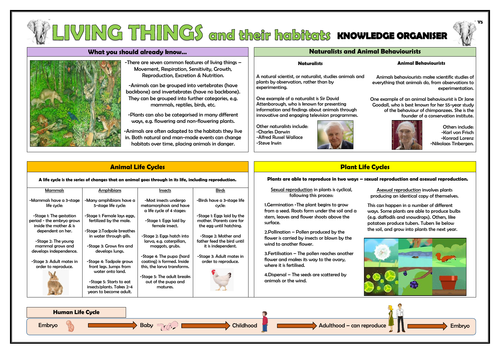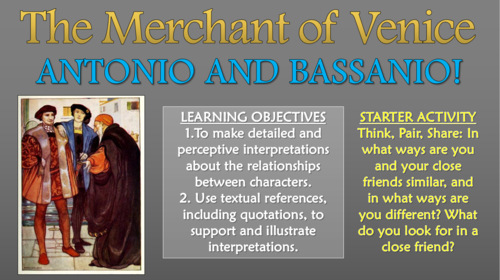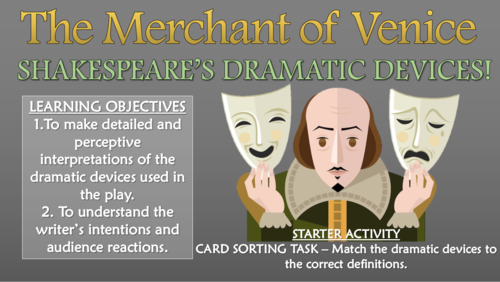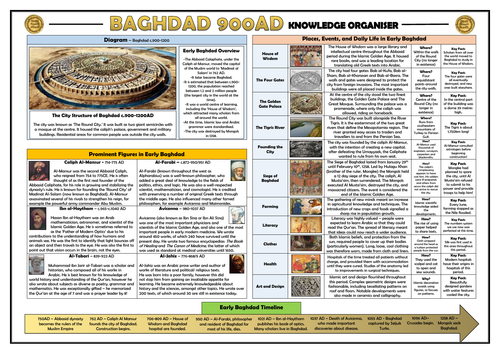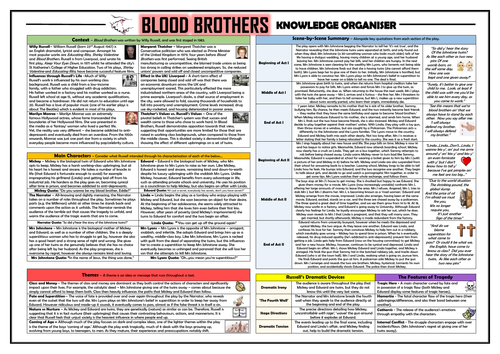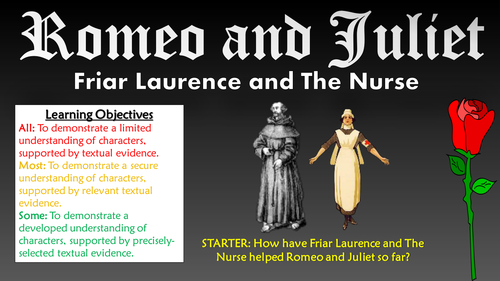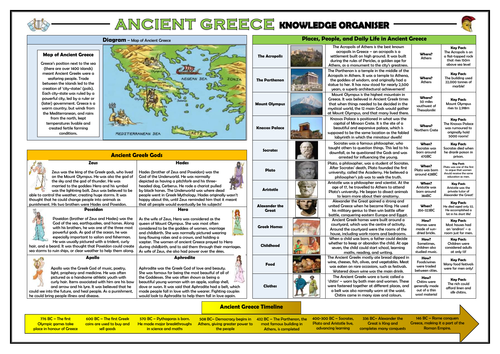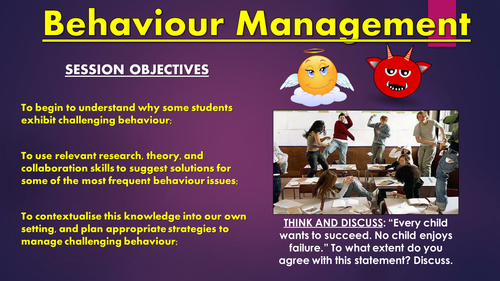
3k+Uploads
1967k+Views
2278k+Downloads
All resources

Harry Potter and the Philosopher's Stone - Story Openings!
This engaging and informative lesson enables students to understand the key techniques used by J.K Rowling in her story opening of 'Harry Potter and the Philosopher’s Stone.' In particular, students comprehend the plot and information in the opening chapter of Harry Potter and analyse what makes the opening effective, before utilising this understanding to compose their own imaginative story opening.
The lesson follows a step-by-step learning journey, in which children learn through:
- Collectively defining the features of effective story openings;
- Reading the opening to Harry Potter and the Philosopher's Stone, identifying the story opening techniques and comprehending the key events and information in the chapter;
- Analysing the effectiveness of each of Rowling's story opening techniques;
- Creating their own engaging story openings, utilising story opening techniques effectively and imaginatively throughout;
- Peer assessing each other's learning attempts.
Included is:
- Whole lesson PowerPoint - colourful and comprehensive;
- The opening chapter of Harry Potter and the Philosopher's Stone (freely available online);
- Effective Story Openings analysis template;
- Teacher answer sheet;
-Comprehensive lesson plan.
All resources are provided in Word (for easy editing) and PDF (to ensure formatting remains fixed between different computers).
There are also opportunities for group learning, speaking and listening, peer assessment, and whole class discussion. I originally used these resources with year 7/8 classes, however colleagues have used them for between years 3 and 10 with some adaptations.
All images are licensed for commercial use, and image rights are listed on the last page of the presentation.

Harry Potter and the Philosopher's Stone Knowledge Organiser/ Revision Mat!
This detailed and visually-appealing resource offers a complete reference point for students learning or revising J.K Rowling's 'Harry Potter and the Philosopher's Stone.' It contains comprehensive sections on:
- Context;
- Chapter by Chapter Summary (with quotes);
- Main Characters;
- Themes;
- Rowling's Language Devices;
- Features of Fantasy Novels.
All key words and ideas are compartmentalised for easy reference. The resource is designed to be printed onto A3, and is provided as both a PDF and a Word version (so that you can edit if you want to). All images used are licensed for commercial use and are cited on a separate document (included).

Harry Potter and the Philosopher's Stone - Lord Voldemort!
This engaging and informative lesson enables students to understand the key features of effective villains, as characterised by Lord Voldemort in J.K Rowling’s 'Harry Potter and the Philosopher’s Stone.' In particular, students highlight key character traits of Voldemort evident in Chapter 17 of Harry Potter and the Philosopher’s Stone (e.g. lack of empathy, hideous appearance, links to the hero, and a clear goal/objective), before utilising this understanding to create and describe their own effective villains.
The lesson follows a step-by-step learning journey, in which children learn through:
- Comprehending Voldemort's role in the novel leading up to the Chapter 17;
- Collectively defining the features of effective villains;
- Reading Chapter 17 of Harry Potter and the Philosopher's Stone, identifying and explaining his characterisation as a villain;
- Analysing the effectiveness of each of Rowling's techniques in creating the image of an effective villain;
- Creating and describing their own imaginative villains, utilising the features of villains effectively and imaginatively throughout;
- Peer assessing each other's learning attempts.
Included is:
- Whole lesson PowerPoint - colourful and comprehensive;
- Paper extract of Chapter 17 of Harry Potter and the Philosopher's Stone (freely available online);
- Lord Voldemort analysis template;
- Create Your Own Villain template;
-Comprehensive lesson plan.
All resources are provided in Word (for easy editing) and PDF (to ensure formatting remains fixed between different computers).
There are also opportunities for group learning, speaking and listening, peer assessment, and whole class discussion. I originally used these resources with year 7/8 classes, however colleagues have used them for between years 3 and 10 with some adaptations.
All images are licensed for commercial use, and image rights are listed on the last page of the presentation.

New GCSE English Language - Comparing and Contrasting
This informative and engaging double lesson aims to improve students’ ability to compare and contrast two different texts based on a similar subject. They will focus particularly on the purpose, audience, language, and structure of texts, and will learn to use comparing and contrasting connectives to highlight any similarities and differences. This has always been a crucial skill in English, but has an increased importance in the new GCSE for English Language, as there is a greater requirement for students to be able to make links and comparisons between texts.
The lesson follows a clear and logical learning journey, with students learning to:
- Understand the key terms 'compare' and 'contrast', and the importance of these skills in English;
- Categorise the different features that they can compare, under the headings 'Purpose', 'Audience', 'Language' and 'Structure;'
- Read (and identify the key features within) two morally and ethically intriguing texts, offering diverse views of young people in the media;
-Compare the two texts, using a clear and concise template, and newly-acquired knowledge of different types of connectives;
- Peer-assess each other's comparative essay attempts.
Included in this resource pack are:
- Whole double lesson, colourful and engaging PowerPoint presentation (Including assessment for learning referral slides)
- Cards for card-sorting activity;
- Two interesting and thought-provoking non-fiction media extracts (one a newspaper extract from The Evening Standard, and another a persuasive leaflet, both focused on the issue of how young people are perceived.)
- Template for main comparative analysis task;
- Full teacher guidance plan.
All images are licensed for commercial use and are cited on the final slide of the PowerPoint presentation

Elizabeth I Knowledge Organiser!
This clear, detailed and visually-appealing resource offers a complete reference point for children learning about Elizabeth I as a part of their history study of ‘Significant Individuals.’ It contains comprehensive sections entitled:
Overview;
Times in Her Life;
Important Vocabulary;
Elizabeth I Timeline;
Answers to the Important Questions;
Top Ten Facts.
The resource is designed to be printed onto A3, and is provided as both a PDF and a Word version (so that you can edit if you want to). All images used are licensed for commercial use.

Year 5 Living Things and their Habitats Knowledge Organiser!
This clear, detailed and visually-appealing resource offers a complete reference point for Year 5 children, teachers and parents covering knowledge relating to ‘Living things and their habitats’, as a part of their science learning. It contains comprehensive sections on:
What you should already know (from learning in earlier years);
Animal Life Cycles;
Plant Life Cycles;
Habitat Changes;
Naturalists and Animal Behaviourists;
Key Vocabulary.
The content is fully aligned with the NC expectations for Year 5 children relating to ‘Living things and their habitats’:
-Describe the differences in the life cycles of a mammal, an amphibian, an insect and a bird;
-Describe the life process of reproduction in some plants and animals.
The resource is designed to be printed onto A3, and is provided as both a PDF and a Word version (so that you can edit if you want to). All images used are licensed for commercial use and are cited on a separate document (included).

The Merchant of Venice - Antonio and Bassanio!
This engaging and informative lesson enables students to make clear and precise interpretations regarding the relationship between Antonio and Bassanio in Shakespeare’s The Merchant of Venice. In particular, students read and understand Act one scene one of the play, interpreting how Antonio and Bassanio’s relationship is introduced, before tracking how their friendship develops over the course of the play.
The lesson follows a step-by-step learning journey, in which children learn through:
Considering the key components of strong friendships;
Reading Act One Scene One and comprehending how Antonio and Bassanio’s friendship is introduced;
Tracking how their friendship develops over the play, using apt textual evidence;
Considering multiple interpretations of Antonio and Bassanio’s relationship;
Applying their understanding of Antonio and Bassanio’s relationship to create an original composition;
Self assessing their learning attempts;
Included is:
Whole lesson PowerPoint - colourful and comprehensive;
Antonio and Bassanio development worksheet;
Extract - Act One Scene One
Character profile template
Comprehensive lesson plan.
Resources are provided in PDF (to maintain formatting), Word (so that they are easily editable) and also in zipfiles.
The lesson contains opportunities for group learning, speaking and listening, peer assessment, and whole class discussion. I originally used these resources with year 10 and 11 classes, however colleagues have used them for between year 9 and year 13 with some adaptations.
All images are licensed for commercial use, and image rights are listed on the last page of the presentation.

The Merchant of Venice - Shylock!
This engaging and informative lesson enables students to make clear, detailed and well-informed interpretations of Shylock from The Merchant of Venice. In particular, students develop their contextual understanding of how Jews were perceived in Shakespeare’s time, make precise interpretations about his character using evidence from the play and link their findings to their understanding of social and historical context.
The lesson follows a step-by-step learning journey, in which children learn through:
Knowledge harvesting their understanding of the Judaism and the treatment of Jews throughout history;
Researching and sharing how Jews were perceived in Shakespeare’s era;
Reading selected quotations from the play and interpreting what these reveal about Shylock’s character;
Plotting Shylock’s development over the course of the play;
Linking their knowledge of Shylock’s character to their understanding of historical context;
Understanding Shakespeare’s intentions/messages in presenting Shylock in the manner that he did;
Peer assessing each other’s learning attempts;
Included is:
Whole lesson PowerPoint - colourful and comprehensive;
Shylock character development graph;
Jigsaw pieces for the group jigsaw activity;
Essay template
Comprehensive lesson plan.
There are also opportunities for group learning, speaking and listening, peer assessment, and whole class discussion. I originally used these resources with year 10 and 11 classes, however colleagues have used them for between year 8 and year 13 with some adaptations.
All images are licensed for commercial use, and image rights are listed on the last page of the presentation.

The Merchant of Venice - Shakespeare's Dramatic Devices!
This engaging and informative lesson enables students to make clear and precise interpretations regarding Shakespeare’s use of dramatic devices in The Merchant of Venice. In particular, students read and understand several extracts from the play, before identifying and then analysing the effect of the dramatic devices that Shakespeare employs throughout.
The lesson follows a step-by-step learning journey, in which children learn through:
Defining and exemplifying a variety of dramatic techniques;
Reading and comprehending a number of key events from the play, identifying the dramatic devices utilised;
Analysing Shakespeare’s use of dramatic devices through considering context and the effect on the audience;
Creating their own dramatic device-filled playscripts, and evaluating their partner’s attempts;
Self assessing their learning through the lesson;
Included is:
Whole lesson PowerPoint - colourful and comprehensive;
Dramatic devices cards for the card-sorting activity;
Analysis worksheets - different degrees of difficulty (asides, dramatic irony, dramatic tension & soliloquy);
A model example of a completed analysis worksheet;
Comprehensive lesson plan.
Resources are provided in PDF (to maintain formatting), Word (so that they are easily editable) and also in zipfiles.
The lesson contains opportunities for group learning, speaking and listening, peer assessment, and whole class discussion. I originally used these resources with year 10 and 11 classes, however colleagues have used them for between year 9 and year 13 with some adaptations.
All images are licensed for commercial use, and image rights are listed on the last page of the presentation.

Baghdad 900AD Knowledge Organiser/ Revision Mat!
This clear, detailed and visually-appealing resource offers a complete reference point for students learning or revising knowledge relating to the ‘Round City’ of Baghdad in years around 900AD. It contains comprehensive sections on:
Early Baghdad overview;
The Round City diagram (annotated);
Prominent figures in early Baghdad;
Early Baghdad timeline;
Places and events in early Baghdad;
Early Baghdad daily life.
The resource is designed to be printed onto A3, and is provided as both a PDF and a Word version (so that you can edit if you want to). All images used are licensed for commercial use and are cited on a separate document (included). It is most suitable for children in KS2 and KS3.

Blood Brothers Knowledge Organiser/ Revision Mat!
This detailed and visually-appealing resource offers a complete reference point for students learning or revising Willy Russell’s ‘Blood Brothers.’ It contains comprehensive sections on:
Context;
Scene by Scene Summary (with quotes);
Main Characters;
Themes;
Russell’s Dramatic Devices;
The Features of Tragedy.
Key words and ideas are underlined for easy reference. The resource is designed to be printed onto A3, and is provided as both a PDF and a Word version (so that you can edit if you want to). All images used are licensed for commercial use and are cited on a separate document (included).

Romeo and Juliet: Friar Laurence and The Nurse!
This lesson enables students to gain a detailed understanding of the characters of Friar Laurence and The Nurse in William Shakespeare’s tragedy Romeo and Juliet. Students learn to demonstrate a developed understanding of their character traits, relationships with the title characters, and impact upon plot developments. Students also learn to empathise with the two characters, inferring and interpreting the motives behind their actions.
The lesson utilises a range of tasks, that require students to be attentive and interactive learners. It follows this learning journey:
- Remembering and understanding the impact of Friar Laurence and The Nurse up to Act IV;
- Reading and interpreting Act IV, particularly interpreting and inferring the key involvement of Friar Laurence and The Nurse;
- Identifying and analysing the key features of their characters;
- Empathising with the two characters through a fun and interactive drama activity, in order to understand their motives a little better;
- Anlaysing their impact upon the plot in Act IV, including their influence upon the two title characters;
- Peer/self-evaluating the learning in the lesson.
Included in this resource pack are:
- A well-presented, thorough, and informative, whole-lesson PowerPoint presentation;
- Resources for the reading and interpreting activity - including a teacher answer guide;
- Full Act IV transcript with space for notes;
- 'In Your Shoes' cut-out soles for the development task;
- A template to help scaffold the main task, complete with P.E.E instructions;
All images in this resource are licensed for commercial use, and are cited on the final slide of the lesson presentation.

Ancient Greece Knowledge Organiser!
This clear, detailed and visually-appealing resource offers a complete reference point for students learning or revising knowledge relating to the Ancient Egyptians. It contains comprehensive sections on:
Ancient Greece map (annotated);
Ancient Greek Gods;
Ancient Greece timeline;
Ancient Greek people;
Ancient Greek places;
Ancient Greek daily life.
The resource is designed to be printed onto A3, and is provided as both a PDF and a Word version (so that you can edit if you want to). All images used are licensed for commercial use and are cited on a separate document (included). It is most suitable for children in KS2 and KS3.

Behaviour Management CPD Session!
This CPD session offers an engaging and original approach to improving behaviour management practices. Grounded in educational research, this CPD session is interactive, well-structured, and has been successfully tried and tested. The aim of the CPD session is to develop the knowledge, skills, and strategies needed in order to utilise behaviour management even more effectively in lessons, and it achieves this by embarking upon the following learning journey:
1. Fully understanding the various reasons for challenging behaviour;
2. Observing and analysing behaviour management practices through a Youtube video;
3. Evaluating the main behaviour concerns in the participants' school/classrooms
4. Gaining familiarity with a range of research and theory suggesting the best methods and strategies for a number of different challenging situations;
5, Planning effective behaviour management strategies to prevent and combat challenging behaviour in the participants' real-life classrooms.
Included in this pack are: Full PowerPoint presentation, a hyperlinked video for analysis, cards fro the Diamond Nine activity, a top tips helpsheet, instructions for the main group task, and guidance for trainers/ presenters.
All images and videos are licensed for commercial use, and are cited on the final slide.
Bundle

Love and Relationships Poetry Lesson Bundle!
These engaging, varied, and informative lessons have been designed to help students gain a valuable understanding of the content, language, and structure features of a range of Love and Relationships poems. Each of the poems are widely studied, with some being from the Literary Heritage bank, and most being fixtures in examination board anthologies:
- Simon Armitage - Mother, Any Distance
- Lord Byron - When We Two Parted
- Carol Ann Duffy - Before You Were Mine
- James Fenton - In Paris with You
- William Shakespeare - Sonnet 116
In addition to this, the lesson on comparing poems is also included - essential for exam technique!
Students will vital skills in: interpreting the significant meanings poems, understanding the writer's ideas within poems, understanding the social and historical contexts of poems, and analysing features of content, language, and structure.
Stimulating, visual, and easily adaptable, these lessons provide suggested learning objectives and outcomes for students of a wide-range of abilities - The vast majority of tasks are differentiated to allow for different abilities and needs in your classroom. Each lesson loosely follows this logical learning journey to ensure that students learn in bite-size steps:
- Engaging
- Defining/ Understanding
- Identifying/Remembering
- Analysing/ Creating
- Peer or self evaluating.
All of the lessons are interactive, employ a variety of different teaching and learning methods and styles, and are visually-engaging. Resources, worksheets, and lesson plans are all provided.
Individually, these resources would amount to £16, meaning that you can save 69%!
These resources can also be bought individually for £2 each
Bundle

Huge SPAG Lesson Bundle!
These engaging and detailed resources have been designed to make the learning of SPAG concepts (particularly prominent in the new curriculum) easily accessible, engaging and interesting for all children. Throughout each lesson, students learn to improve their skill at using appropriate, concise, and precise spelling, punctuation, and grammar, and practice employing them within their own writing compositions. Each lesson contains a comprehensive whole lesson PowerPoint, all of the worksheets/ resources that you will need, and a lesson plan.
The pack also includes a literacy writing mat to help students build their extended writing skills.
All images are licensed for commercial use, and are cited on the final slide of the PowerPoint/ the bottom of worksheets.
Bundle

To Kill a Mockingbird Huge Bundle!
THIS BUNDLE CONTAINS ALL OF THE ‘TO KILL A MOCKINGBIRD’ LESSONS, IN ADDITION TO THE KNOWLEDGE ORGANISER, THE 30-PAGE COMPREHENSION BOOKLET, AND THE POINTLESS GAME!
This engaging, varied, and informative scheme of learning is designed to help students gain understanding, assessment skills, and key interpretations of Harper Lee’s novel ‘To Kill a Mockingbird.’ Made up of a wide-range of interesting and exciting lessons, students should complete this scheme having gathered vital skills in: interpreting the significant meanings of the novel, understanding the writer’s ideas within the text, analysing key characters, settings, and themes, and understanding Lee’s language devices.
Stimulating, visual, and easily adaptable, these lessons provide suggested learning objectives and outcomes for students of a wide-range of abilities - The vast majority of tasks are differentiated to allow for different abilities and needs in your classroom. Each lesson loosely follows this logical learning journey to ensure that students learn in bite-size steps:
Engaging
Defining/ Understanding
Identifying/Remembering
Analysing/ Creating
Peer or self evaluating.
All of the lessons are interactive, employ a variety of different teaching and learning methods and styles, and are visually-engaging. Resources, worksheets, and lesson plans are all provided.
Bundle

Jane Eyre Huge Bundle!
THIS BUNDLE CONTAINS ALL OF THE JANE EYRE LESSONS, IN ADDITION TO THE COMPREHENSION ACTIVITY BOOKLET, THE JANE EYRE KNOWLEDGE ORGANISER, AND THE POINTLESS GAME!
This engaging, varied, and informative scheme of learning is designed to help students gain understanding, assessment skills, and key interpretations of Charlotte Bronte’s ‘Jane Eyre.’ Made up of a wide-range of interesting and exciting lessons, students should complete this scheme having gathered vital skills in: interpreting the significant meanings of the nove, understanding the writer’s ideas within the novel, analysing key characters, settings, and themes, and understanding Bronte’s language devices.
Stimulating, visual, and easily adaptable, these lessons provide suggested learning objectives and outcomes for students of a wide-range of abilities - The vast majority of tasks are differentiated to allow for different abilities and needs in your classroom. Each lesson loosely follows this logical learning journey to ensure that students learn in bite-size steps:
Engaging
Defining/ Understanding
Identifying/Remembering
Analysing/ Creating
Peer or self evaluating.
All of the lessons are interactive, employ a variety of different teaching and learning methods and styles, and are visually-engaging. Resources, worksheets, and lesson plans are all provided.
Bundle

Huge KS2 Science Knowledge Organisers Bundle!
These clear, detailed and visually-appealing resources offer a complete reference point for all 20 units from Years 3-6 within the science National Curriculum.
Year 3 Knowledge Organisers:
-Animals, including Humans;
-Forces and Magnets;
-Plants;
-Rocks;
-Light.
Year 4 Knowledge Organisers:
-Animals, including Humans;
-Electricity;
-Living Things and their Habitats;
-Sound;
-States of Matter.
Year 5 Knowledge Organisers:
-Animals, including Humans;
-Earth and Space;
-Forces;
-Living Things and their Habitats;
-Properties and Changes of Materials.
Year 6 Knowledge Organisers:
-Animals, including Humans;
-Evolution and Inheritance;
-Electricity;
-Living Things and their Habitats;
-Light.
The organisers are separated into logical compartments, based on the key curriculum expectations.
Each resource is designed to be printed onto A3, and is provided as both a PDF and a Word version (so that you can edit if you want to). All images used are licensed for commercial use and are cited on a separate document (included).
Bundle

Magazine Project Bundle!
This lesson and resource bundle provides all that is needed to aid students in composing their own short magazines, on a subject/genre of their choice. Everything that is needed to teach the project is provided, including engaging lesson powerpoints, worksheets, model examples, and activities, and also comprehensive lesson plans for each stage.
Each engaging and informative lesson aids students in learning about and then composing a different magazine page. Included are lessons on:
- Choosing the Genre and Audience and Composing a Front Cover
- Writing Agony Aunt/ Uncle Pages
- Writing Feature Articles
- Writing Reviews
Throughout each lesson, students learn through defining techniques, identifying ‘what a good one looks like’ and analysing model examples, before using writing help-sheets and success criteria to design their own.
All images are cited on the final slides of each PowerPoint.

